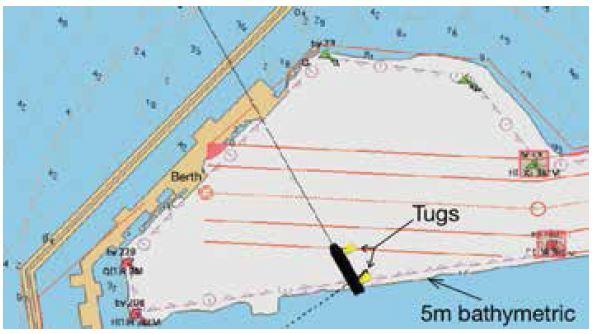201712 Bottom contact goes unnoticed
A relatively small LPG carrier, in ballast, was being manoeuvred under pilotage in port with two tugs secured on the starboard side. The vessel was equipped with twin propellors and rudders.
Once near the berth, the vessel was pivoted to starboard so as to come port side to. Forward speed was now near zero and both tugs were helping execute the manouevre. Due to the moderate north east wind the vessel began to drift astern during the turn. The vessel was drawing 5.3m aft and as the stern came close to the 5m bathymetric line the Master informed the pilot. The pilot did not appear to take any specific avoiding action and the Master did not challenge the pilot further.
The pivoting manoeuvre was continued, as seen in the diagram, and although the stern swung through water shallower than the aft draft, no impact or vibrations were felt. Within a few minutes the vessel was secured alongside the berth.
Unknown to the Master, pilot and crew, the port side rudder had made contact with the bottom during the pivoting manoeuvre, causing the rudder stock to turn within the steering gear actuator by almost 25 degrees from its midship position. However, the rudder indicators were showing that the rudder was still amidships. This situation was only discovered upon departure when the steering was found to be unreliable and inexplicably unresponsive. The vessel quickly went to anchor and divers soon confirmed that the rudder was misaligned, although the rudder itself was physically undamaged.
Lessons learned
- Before beginning a manoeuvre such as turning your vessel over 90° in a restricted waterway, ensure the vessel is appropriately positioned to safely accomplish this move. In this case, given the NE wind, the turn appears to have been initiated too close to the southern edge of the dredged area which left little margin for error while swinging to starboard.
- In this case, the rudder tests before departure did not reveal the misalignment that had occurred during the previous berthing.
- Even though contact with the bottom had been initially discounted due to the lack of vibrations or other indicators, the stern had swept through an area of less depth than the draft; contact should have been assumed and verified before departure.
- One of the key principles of BRM is the ‘challenge’. In this case the Master ‘informed’ the pilot of the imminent danger, but appears not to have insisted that positive action be initiated to avoid the shallow area astern.

